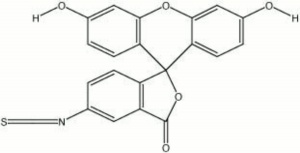Difference between revisions of "Fluorescein isothiocyanate"
| Line 40: | Line 40: | ||
== Additional Information == | == Additional Information == | ||
| − | ° R. Wolbers, N. Sterman, C. Stavroudis, "Notes for Workshop on New Methods in the Cleaning of Paintings", Getty Conservation Institute, Los Angeles, 1990. ° J.Messinger, "Ultraviolet-Fluorescence Microscopy of Paint Cross Sections: Cycloheptaamylose-Dansyl Chloride Complex as a Protein-Selective Stain" JAIC 31:267-74, 1992. | + | ° R. Wolbers, N. Sterman, C. Stavroudis, "Notes for Workshop on New Methods in the Cleaning of Paintings", Getty Conservation Institute, Los Angeles, 1990. |
| + | |||
| + | ° J.Messinger, "Ultraviolet-Fluorescence Microscopy of Paint Cross Sections: Cycloheptaamylose-Dansyl Chloride Complex as a Protein-Selective Stain" JAIC 31:267-74, 1992. | ||
== Authority == | == Authority == | ||
Revision as of 12:45, 15 January 2014
Description
A Fluorescent dye used to detect proteins. Fluorescein isothiocyanate (FITC) is used in biochemistry for the detection of pathogens. It has also been used to detect proteins in paint cross sections (Wolbers et al 1990). However, one study has shown that FITC can also fluoresce with Oil and acrylic media (Messinger 1992). FITC is sometimes incorrectly called Fluorescein.
Synonyms and Related Terms
FITC; 5-FITC; 2-(6-hydroxy-3-oxo-(3H)-xanthene-9-yl)-5-isothiocyanato benzoic acid
Other Properties
Soluble in water, dimethyl formamide, dimethyl sulfoxide.
Maximum absorption wavelength = 490 nm
Maximum emission wavelength = 520 nm
| Composition | C21H11NO5S |
|---|---|
| CAS | 3326-32-7 |
| Melting Point | >360 |
| Molecular Weight | mol. wt. = 389.38 |
Hazards and Safety
Skin contact causes irritation.
Fisher Scientific: MSDS
Additional Information
° R. Wolbers, N. Sterman, C. Stavroudis, "Notes for Workshop on New Methods in the Cleaning of Paintings", Getty Conservation Institute, Los Angeles, 1990.
° J.Messinger, "Ultraviolet-Fluorescence Microscopy of Paint Cross Sections: Cycloheptaamylose-Dansyl Chloride Complex as a Protein-Selective Stain" JAIC 31:267-74, 1992.
Authority
- Richard C. Wolbers, Nanette T. Sterman, Chris Stavroudis, Notes for Workshop on New Methods in the Cleaning of Paintings, J.Paul Getty Trust, Los Angeles, 1990 Comment: mean excitation wavelength = 490 nm -blue and mean emission wavelength = 525 nm
- Aldrich Chemical Catalog Comment: p. 725 - max=499
- Website address 1 Comment: www.mdyn.com/application_notes/technotes - gives max abs =490 and max emission = 520
- Website address 2 Comment: pingu.salk.edu/fcm/fluo.html - gives excitation and emisson as 495, 519
- Website address 3 Comment: www.probes.com/handbook/sections - gives abs and emission as 494, 518
